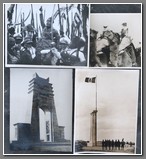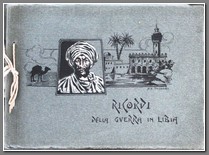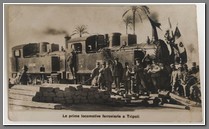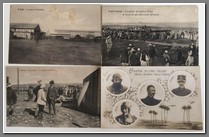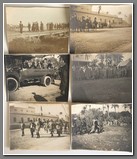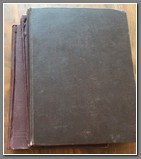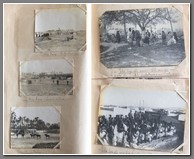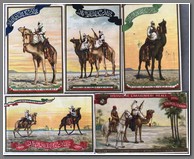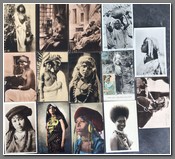Photos and Postcards
Photo album belonging to an Italian officer with the Veston Battalion of the 5th Alpini Regiment immediately following the conquest of Libya and the commencement of rebel operations in 1913. Well captioned, with a beautiful hand painted cover. Raising the Italian flag at Jeffren, ascari NCO’S, Libyan auxiliaries, camels carrying military supplies, Alpini ready to be attacked, military camp at Merg, mission of Arab chiefs at Merg, Italians constructing a road, garrison life, winter snow at Garion, arrival of Minister Bertolini at Garion, port of Tobruk, local markets, battlefield dead, more. 131 photos in all. B
Price: $1200.00
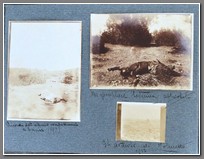 MPH 236Note from Wikipedia: When Italy declared war on Turkey in 1911 in an attempt to conquer Libya, the Alpini units were once again deployed on desert combat. From 1911 to 1914, the Saluzzo, Mondovì, Ivrea, Verona, Tolmezzo, Feltre, Susa, Vestone, Fenestrelle, and Edolo battalions, together with the Torino-Susa, Mondovì, and Vicenza artillery groups, were deployed to Libya on missions of different duration. The first units to be sent to Libya were the Saluzzo (25 October 1911), Mondovì (3 November 1911), Ivrea (3 November 1911) and Verona (16 December 1911) battalions. When the unexpected Turkish resistance caused an embarrassingly slow advance of the Italian forces, reinforcements were sent to Libya. On October 18, 1912 Turkey and Italy signed the Treaty of Lausanne, which ended the war between the two nations. Italy, however, had now to face a full-scale rebellion by the local population, and required more troops than those deployed in combat to suppress it. Therefore, in October 1912 the Tolmezzo, Feltre, Susa, and Vestone battalions were deployed in Zanzur, Libya, and formed the 8th Special Alpini Regiment (Italian: 8° Reggimento Alpini Speciale) under the command of Colonel Antonio Cantore. The last Alpini unit to leave Libya was the Feltre battalion. It reached Italy in August 1914, while the Bedouin rebellion in Libya continued unabated.
MPH 236Note from Wikipedia: When Italy declared war on Turkey in 1911 in an attempt to conquer Libya, the Alpini units were once again deployed on desert combat. From 1911 to 1914, the Saluzzo, Mondovì, Ivrea, Verona, Tolmezzo, Feltre, Susa, Vestone, Fenestrelle, and Edolo battalions, together with the Torino-Susa, Mondovì, and Vicenza artillery groups, were deployed to Libya on missions of different duration. The first units to be sent to Libya were the Saluzzo (25 October 1911), Mondovì (3 November 1911), Ivrea (3 November 1911) and Verona (16 December 1911) battalions. When the unexpected Turkish resistance caused an embarrassingly slow advance of the Italian forces, reinforcements were sent to Libya. On October 18, 1912 Turkey and Italy signed the Treaty of Lausanne, which ended the war between the two nations. Italy, however, had now to face a full-scale rebellion by the local population, and required more troops than those deployed in combat to suppress it. Therefore, in October 1912 the Tolmezzo, Feltre, Susa, and Vestone battalions were deployed in Zanzur, Libya, and formed the 8th Special Alpini Regiment (Italian: 8° Reggimento Alpini Speciale) under the command of Colonel Antonio Cantore. The last Alpini unit to leave Libya was the Feltre battalion. It reached Italy in August 1914, while the Bedouin rebellion in Libya continued unabated.
Photo collection from an Italian officer with the 10th Battalion of the 110th Fanteria Regiment, in Libya, 1912-1913. His name was Capitano Fucconi and he was based at and around Derna. It appears that he accompanied Ambassador Pietro Bertolini on his inaugural trip to Libya as the first Minister of Colonies. Shown are the fort at Buder, military observation post, group of officers posing, monument to a fallen offer, Fort Piemonte, senior officers with local arab chiefs, Camp Rossa at Derna, military cemetery, local inhabitants, arab homes, redout at Sidi Garbia, Italian military undertaking road construction at Camp Rossa, arab prisoners, hillside grottos at Derna, rare photos of General Caneva, reception for a high ranking Italian noble, Italians in arab costumes, meteorological survey work, awarding a sliver medal, stores of heavy artillery, radio telegraph station, rare photo of Italian cavalry. 96 photos, almost all captioned in the hand of Captain Fucconi. B
Note from Wikipedia: Pietro Bertolini ( Montebelluna , July 24, 1859 – Turin , November 28, 1920) was an Italian politician. He was the first Italian colonial minister. Bertolini began his career as a lawyer and student of economic and administrative issues, became mayor of Montebelluna in 1885 and entered Parliament in 1891 as deputy for Montebelluna. Two years later, he became under-secretary for finance in the Crispi IV cabinet . He was then under-secretary in the Ministry of the Interior in the Pelloux II cabinet (1898-1900), in which he was, so to speak, the representative of the party of Baron Sidney Sonnino. At the fall of General Luigi Pelloux, he hoped to regain his position in a future Sonnino ministry; but as the latter seemed less and less likely, Bertolini lost patience and joined Giovanni Giolitti. His conduct in abandoning his former leader was much criticized at the time, but his new boss chose him as Minister of Public Works and Transport in the 1907 cabinet. He proved to be an able administrator, especially when faced with the almost total destruction of Messina and Reggio Calabria following the terrible earthquake of 1908. His abilities allowed rapid aid to survivors and efficient reconstruction of the two destroyed cities, making best use of the bulk purchasing and transportation capabilities of the railway system he had reorganized as Minister of Public Transport.
In 1912, he headed a three-member commission (along with Guido Fusinato and Giuseppe Volpi ) to negotiate peace with Turkey after the Libyan War . In October, the peace treaty was signed and Bertolini was appointed Minister of the Colonies. He then went to Libya to organize the new administration and negotiate the restitution of certain leaders of the rebellion, incorporating them into the Italian army; however, upon his return to Rome, he was informed that the Italian army command had executed the leaders of the rebellion, so the armed rebellion did not end until 1934.
In 1919, Francesco Saverio Nitti appointed him president of the Italian delegation to the Reparations Commission at Versailles, where he obtained significant compensation for Italy from Germany and Austria (to which England and France were trying to oppose). He died in Turin of a heart attack on his return from Paris to Rome.
Price: $2500.00
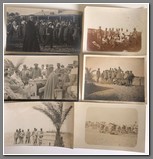 MPH 232 MPH 232 | 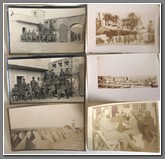 MPH 232 MPH 232 | 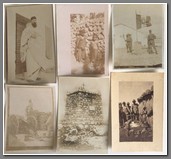 MPH 232 MPH 232 |
Three photo albums belonging to one Frank Scotti, who was based in Eritrea from 1912-1914. He commanded the 2nd company of the 1st Indigenous Battalion. He leaves Rome in early 1912 and spends a short time in Eritrea, gathering his unit at Agordat. He then transfers with his Eritreans to Libya, landing at Tripoli June 17. This album contains many news clippings of his units actions, along with letters and postcards. There are roughly 450 original (non-commercial) photos, most with captions, along with numerous postcards and press clipping. This is the most comprehensive photo album I have seen on an Eritrean Battalion. B
Price: $6000.00
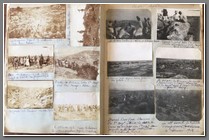 ETH 364 ETH 364 | 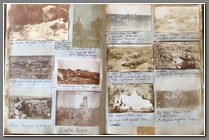 ETH 364 ETH 364 | 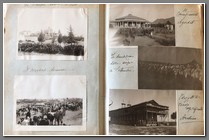 ETH 364 ETH 364 |
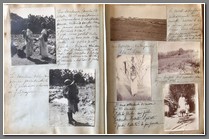 ETH 364 ETH 364 | 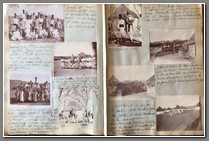 ETH 364 ETH 364 | 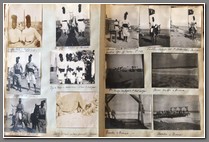 ETH 364 ETH 364 | 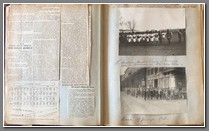 ETH 364 ETH 364 |
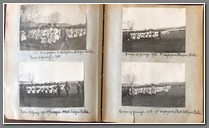 ETH 364 ETH 364 | 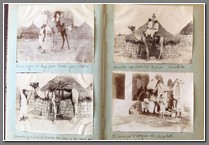 ETH 364 ETH 364 | 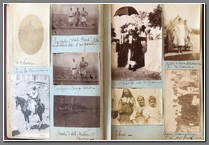 ETH 364 ETH 364 | 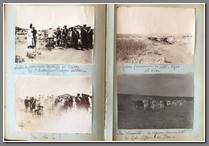 ETH 364 ETH 364 |
Well captioned group of mounted photos of Italian occupied Libya 1911-1913. Numerous small towns are shown, Eritrean ascaris arriving and mixing with local arabs, mostly devoted to the ascaris in Libya, so this album belonged to an officer in an Eritrean battalion. The photographer had a very good camera and a very good eye. Well captioned, with named senior Italian officers. 87 large format photos in all. B
Price: $1500.00
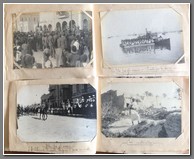 MPH 229 MPH 229 | 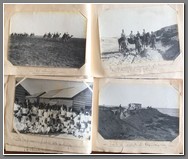 MPH 229 MPH 229 | 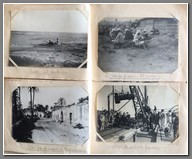 MPH 229 MPH 229 |

